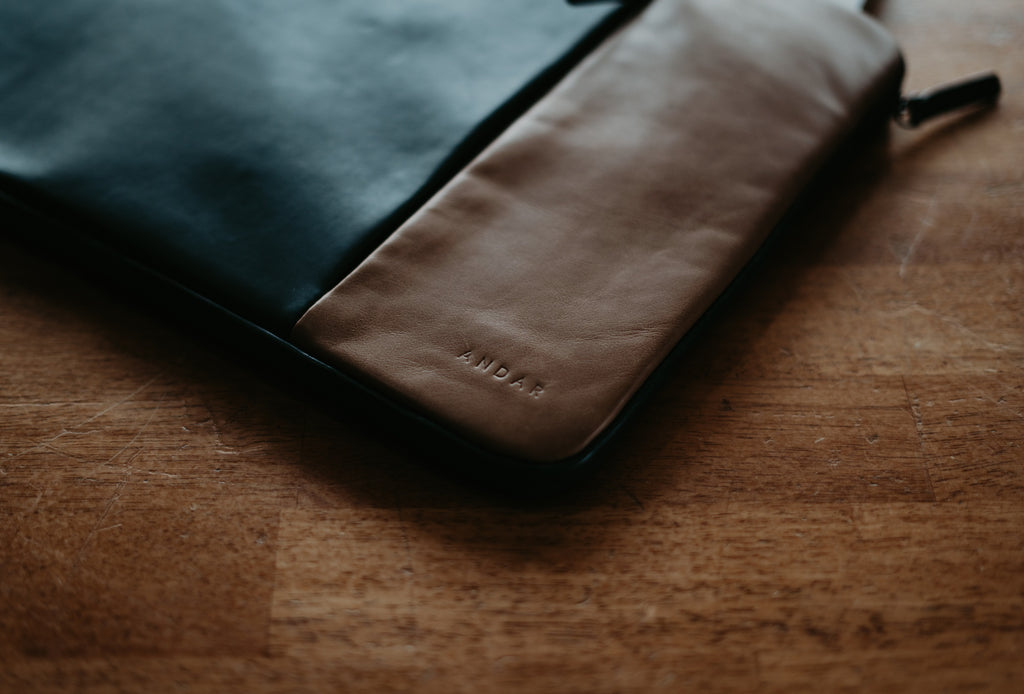One of the best parts about owning a full grain leather good is that it will age beautifully and develop its own unique patina. Because it’s the highest grade of leather, full grain leather doesn’t require much maintenance. But a leather good that’s been everywhere you have may be susceptible to dirt, scratches, and smudges. All of these seemingly imperfect marks are actually desirable because they tell a story and can only be found on full grain leather goods. (You can learn more about full grain leather and its advantages here.) However, you might want to restore it to the pristine condition it was in when you first bought it. If so, make sure you follow this regimen so you can keep your leather looking fresh.

Cleaning your leather
When it comes to caring for full grain leather, the key is a light touch and a mild cleaning product. Stay away from leather cleaners and saddle soap. You might think these products are fine for cleaning your full grain leather, but they’re better suited for products meant to withstand a lot of wear and tear, like sofas or boots (and even many of these would be ruined by leather cleaner or saddle soap). The harsh chemicals in these cleaners could affect the color, strength, and texture of your leather.
Instead, when cleaning full grain leather, you’ll want to use a soft microfiber cloth, warm water, and a mild hand soap. Dip the cloth in the soapy water and wring it out so it’s only damp, not saturated. Gently rub it on the leather—be sure not to scrub! This should be sufficient to remove any dirt or oil stains. When you’re done with this step, wipe off the leather with a dry cloth. Again, be gentle; you don’t want to rub too hard and risk warping the leather. Let the leather completely dry in the shape you want your product to remain in (for example, if you’re cleaning a bifold wallet, let it dry in the folded position). Let it dry naturally and don’t use any heaters, hairdryers, or direct sunlight. Any of these can fade and warp the leather, so it’s very important that you let your product dry at room temperature.
Once your leather good is dry, you’ll want to use a leather cream or conditioner to keep the leather supple and waterproof. Take a soft cloth, sponge, or cotton towel, dip it in the cream, and rub it evenly and gently into the leather.

Maintaining your leather
The best way to avoid staining your leather good is to wipe everything away right when it gets on the leather. This includes simple water spills—full grain leather is water resistant, but letting water sit on your product for a prolonged time will still leave a stain. Make sure to immediately wipe away any spills or smudges. If you want to be extra sure to keep your leather looking pristine, it’s a good idea to wipe it down with a slightly damp cloth every so often and clean it with soap and water once every few months. This will also reduce any marks that come with the natural oils on your hands, although many leather owners find these marks to be a desirable trait instead of something to be avoided.
Restoring your leather
Every scratch and smudge tells the story of where your leather has been: one scratch may show how you dropped it in a bush while hiking; a water stain may be from when you were caught in a storm in a rainy vacation destination. Because leather is unique in that these imperfections add to rather than take away from its rich appearance, many people find these marks to be a positive aspect of owning a leather good. However, if you want to restore your leather to the way it looked when you first got it, a good leather cream will do the trick. Simply follow the last step in the leather cleaning process: using a soft cloth, rub the cream into the leather until the marks disappear.
Imperfections Tell A Story
It’s important to note that every full grain leather good will develop marks and slight imperfections due to it being a natural substance. The slight color change that results from age and exposure is known as patina, and it’s part of what makes leather such a desirable material. Sometimes, what you think might be dirt on your leather could actually just be the natural patina. Remember that this is a good thing, and it shows everywhere your leather has been with you. You can restore it close to its original state using these maintenance steps, but sometimes, it’s best to just let your leather tell its story through the imperfections.

Junyuan Bags | Professional Bag Manufacturer
Ten articles before and after
Organizing Your Everyday Carry – Junyuan Bags
How to Build Your Everyday Carry – Junyuan Bags
A History of Wallets – Junyuan Bags
How to Create a Goal-Driven Workspace – Junyuan Bags
Did You Know? 5 Reasons to Slim Your Wallet – Junyuan Bags
Travel: Packing the Essentials, Ditching the Excess – Junyuan Bags
Full Grain Leather vs. Genuine Leather: What's Better? – Junyuan Bags
Why Cork Wallets? – Junyuan Bags
The Prereq to Minimalism: Reducing Your Everyday Carry – Junyuan Bags




 Mobile/What's App/Wechat
Mobile/What's App/Wechat E-Mail
E-Mail ADD
ADD




